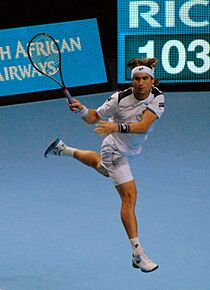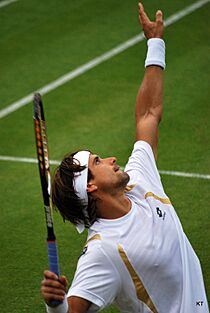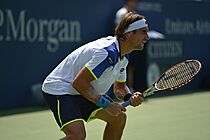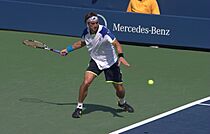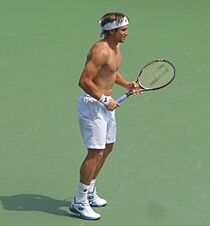David Ferrer facts for kids
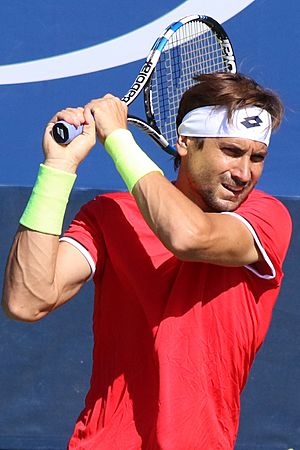
Ferrer at the 2016 US Open
|
|
| Country (sports) | |
|---|---|
| Residence | Valencia, Spain |
| Born | 2 April 1982 Xàbia, Alicante, Spain |
| Height | 1.75 m (5 ft 9 in) |
| Turned pro | 2000 |
| Retired | 2019 |
| Plays | Right-handed (two-handed backhand) |
| Coach | Javier Piles (2000–2013) José Francisco Altur (2014) Francisco Fogués (2014–2019) |
| Prize money | US$31,483,911
|
| Singles | |
| Career record | 734–377 (66.07%) (66.1%) |
| Career titles | 27 |
| Highest ranking | No. 3 (8 July 2013) |
| Grand Slam singles results | |
| Australian Open | SF (2011, 2013) |
| French Open | F (2013) |
| Wimbledon | QF (2012, 2013) |
| US Open | SF (2007, 2012) |
| Other tournaments | |
| Tour Finals | F (2007) |
| Olympic Games | 3R (2012) |
| Doubles | |
| Career record | 77–113 (40.53%) (40.5%) |
| Career titles | 2 |
| Highest ranking | No. 42 (24 October 2005) |
| Grand Slam doubles results | |
| Australian Open | 3R (2005) |
| French Open | 2R (2009) |
| Wimbledon | 1R (2003, 2004, 2005, 2006, 2009, 2018) |
| US Open | 2R (2004, 2006) |
| Other doubles tournaments | |
| Olympic Games | SF – 4th (2012) |
| Team competitions | |
| Davis Cup | W (2008, 2009, 2011) |
| Hopman Cup | RR (2019) |
David Ferrer Ern was a professional tennis player from Spain. He was born on April 2, 1982. In July 2013, he reached his highest ranking as world No. 3 in men's singles. David Ferrer won 27 singles titles on the ATP Tour. This included a big win at the 2012 Paris Masters.
He also reached the finals of major tournaments. These included the 2013 French Open and the 2007 Tennis Masters Cup. Ferrer helped Spain win the Davis Cup three times. He is known for winning the most matches on the ATP Tour without winning a major title. Many consider him one of the best players never to have won a Grand Slam.
Ferrer started his professional career in 2000. Early on, he was known as a clay court specialist. He won 13 of his 27 titles on clay. However, he also did very well on other surfaces. He reached the French Open final in 2013 without losing a single set. He also made it to the semifinals of the Australian and US Open twice. He reached the quarterfinals of Wimbledon twice. David Ferrer retired from tennis in 2019. His last tournament was the Madrid Open in his home country.
Contents
- David Ferrer's Tennis Journey
- Starting Out: 1999–2001
- First Big Wins: 2002–2003
- Climbing the Ranks: 2004–2005
- Breaking into the Top 10: 2006–2007
- Davis Cup Champion: 2008–2009
- First Masters Final: 2010
- More Success and Davis Cup: 2011
- Olympic Doubles and First Masters Title: 2012
- World No. 3 and French Open Final: 2013
- Consistent Performance: 2014–2015
- Later Career and Retirement: 2016–2019
- Playing Style and Reputation
- Personal Life
- Rivalries
- Career Statistics
- Images for kids
- See also
David Ferrer's Tennis Journey
Starting Out: 1999–2001
David Ferrer was born in Xàbia, Spain. When he was 13, he moved to Gandia. Two years later, he moved to Barcelona to train at the Catalan Tennis Federation.
As a teenager, Ferrer once didn't practice hard enough. His coach, Javier Piles, locked him in a small, dark closet. He was given only bread and water. After this, Ferrer felt like quitting tennis. He even worked at a construction site for a week. But he soon returned to Piles and asked to keep playing. Piles coached Ferrer until the end of 2013. Ferrer often said Piles was like a second father to him.
Ferrer became a professional player in 2000. He finished that year ranked world No. 419. In 2001, he won his first Challenger title in Sopot.
First Big Wins: 2002–2003
In 2002, Ferrer played well in both ATP and Challenger tournaments. He won his first ATP title in Bucharest. He also reached his first ATP final in Umag. All his ATP wins that year were on clay courts.
A big moment in 2003 was when Ferrer beat Andre Agassi at the Rome Masters. He played in all four Grand Slam tournaments for the first time. He reached the second round at the French Open and Wimbledon. He finished 2003 ranked world No. 71.
Climbing the Ranks: 2004–2005
In 2004, Ferrer reached the quarterfinals in several tournaments. He also made it to the semifinals in Stuttgart. He ended the year ranked world No. 49.
In 2005, Ferrer reached the semifinals in Miami. He beat strong players like David Nalbandian and Juan Carlos Ferrero. He also won his first two ATP doubles titles. He finished 2005 ranked world No. 14.
Breaking into the Top 10: 2006–2007
Ferrer entered the top 10 ATP rankings for the first time in 2006. This happened after he reached the fourth round of the Australian Open. He made it to the semifinals in Miami for the second year in a row. In July, he won his second ATP title in Stuttgart. He saved a match point and came back to win a five-hour final. He finished 2006 ranked world No. 14.
In 2007, Ferrer started strong by winning in Auckland. He then reached the fourth round of the Australian Open. He won his second title of the year in Båstad, Sweden. At the US Open, he upset Rafael Nadal in the fourth round. He reached his first Grand Slam semifinal, where he lost to Novak Djokovic. His performance at the US Open pushed his ranking to world No. 8. He then won his third title of the year in Tokyo.
Ferrer qualified for the year-end Tennis Masters Cup. He beat top players like Djokovic and Nadal in the group stage. He reached the final but lost to Roger Federer. He ended 2007 with a career-high ranking of world No. 5.
Davis Cup Champion: 2008–2009
Ferrer started 2008 by reaching the quarterfinals of the Australian Open. He lost to the eventual champion, Novak Djokovic. In April, he won his first ATP title of the year in Valencia. He saved three match points in the quarterfinals. He also won his first grass-court title in 's-Hertogenbosch, Netherlands. This made him only the second Spaniard to win on grass in 36 years. At the US Open, he lost in the third round to a much lower-ranked player.
In 2009, Ferrer reached the final of the Dubai Tennis Championships. He lost to Novak Djokovic. He also reached the final of the Barcelona Open, losing to Rafael Nadal. Ferrer helped Spain win the Davis Cup title that year. He won his match against Radek Štěpánek in five sets.
First Masters Final: 2010
Ferrer had a strong year in 2010. He reached the final of the 2010 Abierto Mexicano Telcel and won his eighth career title. He beat Juan Carlos Ferrero in the final. This win also ended Ferrero's 14-match winning streak.
He reached his first Masters 1000 final at the 2010 Rome Masters. He beat several top players, including Andy Murray and Jo-Wilfried Tsonga. In the final, he lost to Rafael Nadal. His good performance in Rome moved his ranking to world No. 12. He also reached the semifinals of the 2010 Mutua Madrileña Madrid Open.
Ferrer played in the 2010 US Open. He reached the fourth round, which helped him return to the top 10 rankings. He also reached the final of the 2010 China Open, where he lost to Novak Djokovic. Ferrer won his ninth career title at the 2010 Valencia Open 500. This win helped him qualify for the 2010 ATP World Tour Finals. He finished 2010 ranked world No. 7.
More Success and Davis Cup: 2011
Ferrer started 2011 by winning the 2011 Heineken Open. This was his tenth career title. At the 2011 Australian Open, he reached the semifinals. He famously beat an injured Rafael Nadal in three sets. This ended Nadal's chance to win four major titles in a row. Ferrer lost to Andy Murray in the semifinal. His ranking rose to world No. 6.
He won his second title of 2011 in Acapulco. He beat Nicolás Almagro in the final. Ferrer reached his second Masters 1000 final at the 2011 Monte-Carlo Rolex Masters. He lost to Rafael Nadal. He also reached the final of the 2011 Barcelona Open Banco Sabadell, again losing to Nadal.
At the US Open, he lost in the fourth round to Andy Roddick. He reached another final at the 2011 Shanghai Rolex Masters, losing to Andy Murray. Ferrer had a strong showing at the 2011 ATP World Tour Finals. He beat Andy Murray and Novak Djokovic in the group stage. He lost to Roger Federer in the semifinals. In December, Ferrer helped Spain win the Davis Cup title again. He won his match against Juan Martín del Potro.
Olympic Doubles and First Masters Title: 2012
Ferrer started 2012 by winning in Auckland again. This was his third Auckland title and 12th overall. At the 2012 Australian Open, he reached the quarterfinals. He lost to world No. 1 Novak Djokovic.
He won his second title of 2012 in Argentina. His third title came a week later in Acapulco. He beat Fernando Verdasco in the final. At the 2012 French Open, Ferrer reached his first semifinal there. He beat Andy Murray in the quarterfinals. He then lost to Rafael Nadal.
Ferrer won his fourth title of the year in 's-Hertogenbosch, Netherlands. This was his second grass-court title. He reached the quarterfinals of Wimbledon for the first time. He lost to Andy Murray in a close match. He won his fifth title of the year in Sweden.
At the US Open, Ferrer reached his fourth Grand Slam semifinal. He lost to Novak Djokovic. Ferrer won his sixth title of the season in Valencia. He then won his first ever Masters 1000 title at the Paris Masters. He beat Jerzy Janowicz in the final. This was his seventh ATP Tour title of the year, the most by any player that season. He also won more matches than any other player, male or female, in 2012.
World No. 3 and French Open Final: 2013
Ferrer started 2013 by winning the 2013 Heineken Open again. At the 2013 Australian Open, he came back from two sets down to win his quarterfinal match. He lost to Novak Djokovic in the semifinals. After Rafael Nadal was out with an injury, Ferrer became the top-ranked Spanish player. He reached world No. 4 in January 2013.
He won his second title of 2013 in Argentina. He reached the final of the Miami Masters. He lost to Andy Murray after having a championship point. At the French Open, Ferrer reached his first Grand Slam final. He did this without losing a single set along the way. He beat three fellow Spanish players to reach the semifinals. He then defeated Jo-Wilfried Tsonga to reach the final. In the final, he lost to defending champion Rafael Nadal. Even though he didn't win, he reached a career-high ranking of world No. 3 in July 2013.
He reached the quarterfinals of Wimbledon for the second year in a row. He lost to Juan Martín del Potro. At the US Open, he lost in the quarterfinals in a five-set match. He reached three more finals at the end of the year. He lost all of them, making it seven consecutive final losses. At the end of 2013, he stopped working with his long-time coach, Javier Piles. He finished 2013 ranked world No. 3, his best year-end ranking.
Consistent Performance: 2014–2015
Ferrer started 2014 by winning his first title of the year in Argentina. He reached the quarterfinals of the 2014 Australian Open. At the 2014 Monte-Carlo Rolex Masters, he beat Rafael Nadal on clay for the first time in 10 years. He reached the semifinals of the 2014 Mutua Madrid Open. He made it to the quarterfinals of the 2014 French Open, losing to Rafael Nadal.
Ferrer reached the final of the 2014 Western & Southern Open. He lost to Roger Federer. He finished 2014 ranked world No. 10.

In 2015, Ferrer had a great start. He won his 22nd ATP title at the 2015 Qatar ExxonMobil Open. He beat Tomáš Berdych in the final. He then won back-to-back titles in February in Rio and Acapulco. He reached the semifinals of the Rome Masters. At the 2015 French Open, he reached his fourth quarterfinal there. He lost to Andy Murray.
Ferrer won his 25th career title at the Kuala Lumpur Open. He became the first Spaniard to win that title. He continued his winning streak by winning the Erste Bank Open in Vienna. He won all five finals he played in 2015.
Later Career and Retirement: 2016–2019
In 2016, Ferrer reached the quarterfinals of the Australian Open. He lost to Andy Murray. He continued to play in various tournaments but started to drop in the rankings.
In July 2017, Ferrer won his first tournament since October 2015. This was at the 2017 Swedish Open. He reached the semifinals of the Cincinnati Masters.
In his final Grand Slam appearance at the 2018 US Open, Ferrer faced Rafael Nadal. He had to stop the match early due to a calf injury.
On August 28, 2018, Ferrer announced that 2019 would be his last year on tour. He planned to play in a few specific tournaments. At the Miami Masters, he had a big win. He beat world No. 3 Alexander Zverev. This was his first win against a top 3 player in almost five years.
Ferrer played his final tournament at the Madrid Masters. He lost to Alexander Zverev, ending his amazing career. After retiring, Ferrer became the new director of the Barcelona Open.
Playing Style and Reputation
David Ferrer was known for being a very determined and fit player. He won many matches by playing consistently from the back of the court. He had great fitness and speed. While he didn't hit the ball as hard as some players, he kept the ball deep. This made his opponents move around the court a lot. He was successful on all surfaces, especially clay and hard courts.
Tennis experts like Darren Cahill said Ferrer was one of the best returners in men's tennis. Even Roger Federer called him the best returner in 2007.
Off the court, Ferrer was known as a humble and quiet person. He rarely caused any trouble during his career. He was admired for his toughness and competitive spirit. Many compared his playing style to Lleyton Hewitt because of his speed and strong defense.
In 2016, a video from the ATP highlighted Ferrer's long career. It showed his fighting spirit and consistency. It noted that 2015 was his second-best season, even though he was older. Ferrer has won the most matches and tournaments among players who haven't won a Grand Slam. His tennis idol growing up was Sergi Bruguera.
Personal Life
Ferrer supports the Valencia CF football team. He also enjoys playing basketball.
On November 28, 2015, David Ferrer married his long-time girlfriend, Marta Tornel Nieto. They met in 2008 through Ferrer's coach at the time. Marta has a degree in optometry and works at her family's opticians. On May 4, 2018, Ferrer and Marta announced the birth of their son, Leo.
Ferrer loves to read. His favorite writers are Arturo Perez-Reverte and Ildefonso Falcones. His favorite book is Perez-Reverte's La Reina del Sur (Queen of the South). He keeps every book he reads. Ferrer says he reads books to help him grow as a person, not just a tennis player.
Rivalries
Ferrer vs. Murray
David Ferrer and Andy Murray played each other 20 times. Murray won 14 of those matches, and Ferrer won 6. Ferrer was better on clay courts, winning 4 out of 5 matches. Murray was stronger on hard courts, winning 12 out of 14. They met 5 times at Grand Slam tournaments, with Murray winning 4 of those.
Ferrer vs. Verdasco
Ferrer and Fernando Verdasco played 21 times. Ferrer won 14 matches, and Verdasco won 7. Ferrer had a better record on clay and hard courts. Verdasco won their only match on grass. They met twice at Grand Slams, and Verdasco won both times.
Ferrer vs. Lopez
Ferrer and Feliciano López played 19 times. Ferrer won 11 matches, and Lopez won 8. Ferrer had a better record on clay. Lopez had a slight lead on hard courts. They met three times at the French Open, with Ferrer winning two of those matches.
Ferrer vs. Berdych
Ferrer and Tomáš Berdych played 16 times, with each player winning 8 matches. Berdych had a better record on clay, while Ferrer was stronger on hard courts. They met three times at Grand Slams, and Berdych won all three. Both Ferrer and Berdych are often considered among the best players who never won a Grand Slam.
Ferrer vs. Wawrinka
Ferrer and Stanislas Wawrinka played 14 times, with each player winning 7 matches. They had an even record on clay. Wawrinka had a slight lead on hard courts, and Ferrer won their only match on grass. They never played each other at a Grand Slam tournament.
Ferrer vs. Nishikori
Ferrer and Kei Nishikori played 14 times. Nishikori won 10 matches, and Ferrer won 4. Their first match was at the 2008 US Open, which Nishikori won in five sets. From 2011 to 2013, Ferrer won most of their matches. However, in 2014, Nishikori won all four of their matches. In 2015, Nishikori beat Ferrer at the Australian Open. But Ferrer ended his losing streak by beating Nishikori in the final of the 2015 Abierto Mexicano Telcel.
Career Statistics
Grand Slam Tournament Performance
| Tournament | 2002 | 2003 | 2004 | 2005 | 2006 | 2007 | 2008 | 2009 | 2010 | 2011 | 2012 | 2013 | 2014 | 2015 | 2016 | 2017 | 2018 | SR | W–L | Win % |
|---|---|---|---|---|---|---|---|---|---|---|---|---|---|---|---|---|---|---|---|---|
| Australian Open | A | 1R | 2R | 1R | 4R | 4R | QF | 3R | 2R | SF | QF | SF | QF | 4R | QF | 3R | 1R | 0 / 16 | 41–16 | 72% |
| French Open | Q2 | 2R | 2R | QF | 3R | 3R | QF | 3R | 3R | 4R | SF | F | QF | QF | 4R | 2R | 1R | 0 / 16 | 44–16 | 73% |
| Wimbledon | A | 2R | 2R | 1R | 4R | 2R | 3R | 3R | 4R | 4R | QF | QF | 2R | A | 2R | 3R | 1R | 0 / 15 | 28–15 | 65% |
| US Open | A | 1R | 1R | 3R | 3R | SF | 3R | 2R | 4R | 4R | SF | QF | 3R | 3R | 3R | 1R | 1R | 0 / 16 | 32–16 | 67% |
| Win–loss | 0–0 | 2–4 | 3–4 | 6–4 | 10–4 | 11–4 | 12–4 | 7–4 | 9–4 | 14–4 | 18–4 | 19–4 | 10–4 | 9–3 | 10–4 | 5–4 | 0–4 | 0 / 63 | 145–63 | 70% |
Grand Slam Finals: 1 (1 Runner-up)
| Result | Year | Championship | Surface | Opponent | Score |
|---|---|---|---|---|---|
| Loss | 2013 | French Open | Clay | 3–6, 2–6, 3–6 |
Year–End Championships Performance
| Tournament | 2002 | 2003 | 2004 | 2005 | 2006 | 2007 | 2008 | 2009 | 2010 | 2011 | 2012 | 2013 | 2014 | 2015 | 2016 | 2017 | 2018 | 2019 | SR | W–L | Win % |
|---|---|---|---|---|---|---|---|---|---|---|---|---|---|---|---|---|---|---|---|---|---|
| ATP World Tour Finals | DNQ | F | DNQ | RR | SF | RR | RR | RR | RR | DNQ | 0 / 7 | 8–14 | 36% | ||||||||
Year–End Championship Finals: 1 (1 Runner-up)
| Result | Year | Championship | Surface | Opponent | Score |
|---|---|---|---|---|---|
| Loss | 2007 | Shanghai | Hard (i) | 2–6, 3–6, 2–6 |
Images for kids
See also
 In Spanish: David Ferrer para niños
In Spanish: David Ferrer para niños


